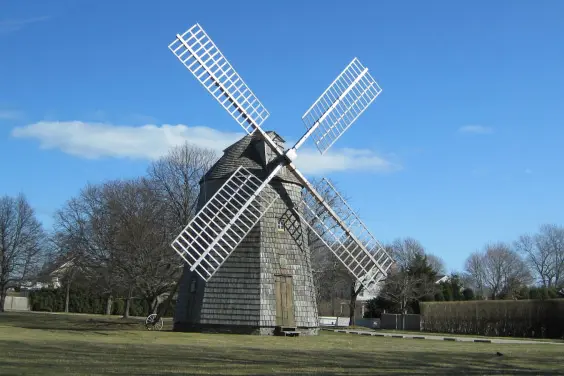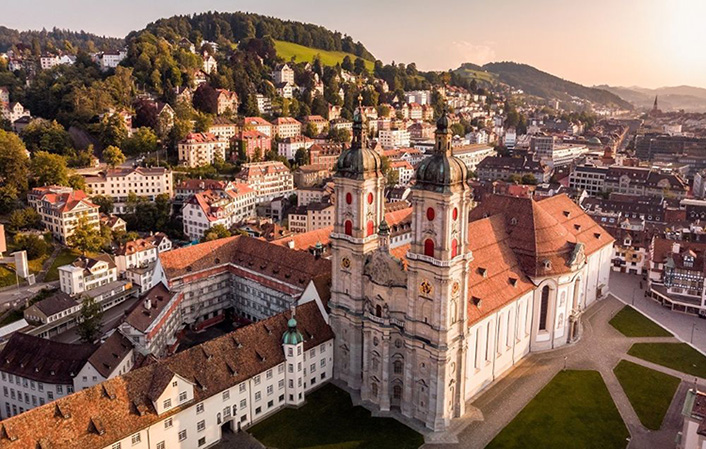Bus from POLKOWICE to ST. GALLEN. Current connections
POLKOWICE

Polkowice is located in the Lower Silesian province northwest of Wroclaw. This small town has a population of more than 22,000 and is primarily famous as a so-called copper town belonging to the Legnica-Glogów Copper District. However, its history goes back much further than the years of the 19th-century industrial revolution. In 1291 Polkowice was granted a city charter, having previously been a market settlement on the trade route between Glogow and Legnica.
When visiting Polkowice, it is essential to see the well-preserved market square, full of colorful tenement houses, together with the town hall building dating back to the 18th century and the Gothic church of St. Michael the Archangel dating back to 1679. The symbol and unquestionable attraction of Polkowice is the Dutch windmill, inside of which you can learn more about the history of this Piast stronghold at the dawn of time, and from the observation deck at its top admire the panorama of the city.
An ideal place for those who want active rest in the midst of nature and greenery will be the Central Park of Fun and Leisure located in the center of Polkowice. On its territory you will find an amphitheater, a playground, a fountain or even an open-air library.
Polkowice - bus, train or own transport
Getting to Polkowice by car or bus should not be a problem, as the city lies on the S3 expressway and provincial road 331. The Polkowice PKS bus stop can be found near the historic windmill on Mlynska Street, from where numerous domestic and international bus connections depart. However, trains do not reach the town and it has no railroad station.
Polkowice is located in the Lower Silesian province northwest of Wroclaw. This small town has a population of more than 22,000 and is primarily famous as a so-called copper town belonging to the Legnica-Glogów Copper District. However, its history goes back much further than the years of the 19th-century industrial revolution. In 1291 Polkowice was granted a city charter, having previously been a market settlement on the trade route between Glogow and Legnica.
When visiting Polkowice, it is essential to see the well-preserved market square, full of colorful tenement houses, together with the town hall building dating back to the 18th century and the Gothic church of St. Michael the Archangel dating back to 1679. The symbol and unquestionable attraction of Polkowice is the Dutch windmill, inside of which you can learn more about the history of this Piast stronghold at the dawn of time, and from the observation deck at its top admire the panorama of the city.
An ideal place for those who want active rest in the midst of nature and greenery will be the Central Park of Fun and Leisure located in the center of Polkowice. On its territory you will find an amphitheater, a playground, a fountain or even an open-air library.
Polkowice - bus, train or own transport
Getting to Polkowice by car or bus should not be a problem, as the city lies on the S3 expressway and provincial road 331. The Polkowice PKS bus stop can be found near the historic windmill on Mlynska Street, from where numerous domestic and international bus connections depart. However, trains do not reach the town and it has no railroad station.
ST. GALLEN

St. Gallen, a city in northeastern Switzerland, located in the canton of the same name, near the borders with Germany and Austria. It is one of the most important cultural, educational and economic centers in the region. The city has a rich history, and its old town is a UNESCO World Heritage Site.
Main attractions:
Abbatiale (St. Gallen Monastery) - The biggest attraction in St. Gallen is the monastery complex, which includes a beautiful church with Baroque architecture. The monastery was once a scientific and spiritual center. Also inside is the monastery's library, which is one of the oldest and most valuable book collections in the world. The library has a collection of more than 170,000 volumes, including medieval manuscripts.
Old Town - St. Gallen has a beautiful old town with narrow, picturesque streets and charming buildings, including colorful townhouses that recall the city's medieval character.
Textile Museum in St. Gallen - The city is known for its textile industry, so a museum dedicated to this area of history and art is one of the highlights of St. Gallen. The museum features unique collections of textiles and clothing from different eras.
Rosenberg Hill - This hill offers a beautiful view of the city and the surrounding Alps. It's a popular place for walking and relaxing, with numerous hiking trails.
St. Gallen Cathedral - This is an impressive building whose construction began in the 11th century. The cathedral has a unique character due to its architecture, with Baroque details.
St. Gallen is one of the main financial, educational and cultural centers in Switzerland. The city is famous for its textile industry, but in recent decades it has also developed in other fields such as banking, international trade and technology. St. Gallen is also a well-known educational center, thanks mainly to the University of St. Gallen (HSG), which is one of the top business universities in Europe.
St. Gallen, a city in northeastern Switzerland, located in the canton of the same name, near the borders with Germany and Austria. It is one of the most important cultural, educational and economic centers in the region. The city has a rich history, and its old town is a UNESCO World Heritage Site.
Main attractions:
Abbatiale (St. Gallen Monastery) - The biggest attraction in St. Gallen is the monastery complex, which includes a beautiful church with Baroque architecture. The monastery was once a scientific and spiritual center. Also inside is the monastery's library, which is one of the oldest and most valuable book collections in the world. The library has a collection of more than 170,000 volumes, including medieval manuscripts.
Old Town - St. Gallen has a beautiful old town with narrow, picturesque streets and charming buildings, including colorful townhouses that recall the city's medieval character.
Textile Museum in St. Gallen - The city is known for its textile industry, so a museum dedicated to this area of history and art is one of the highlights of St. Gallen. The museum features unique collections of textiles and clothing from different eras.
Rosenberg Hill - This hill offers a beautiful view of the city and the surrounding Alps. It's a popular place for walking and relaxing, with numerous hiking trails.
St. Gallen Cathedral - This is an impressive building whose construction began in the 11th century. The cathedral has a unique character due to its architecture, with Baroque details.
St. Gallen is one of the main financial, educational and cultural centers in Switzerland. The city is famous for its textile industry, but in recent decades it has also developed in other fields such as banking, international trade and technology. St. Gallen is also a well-known educational center, thanks mainly to the University of St. Gallen (HSG), which is one of the top business universities in Europe.
© 2025 Sindbad
Technical support, assistance, payments: Sindbad IT
© 2025 Sindbad
Technical support, assistance, payments: Sindbad IT
